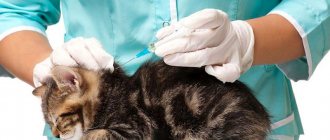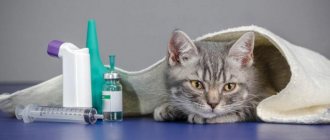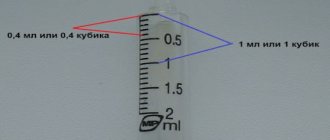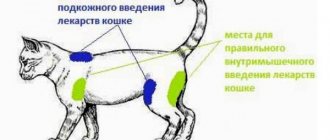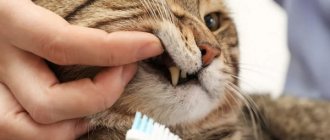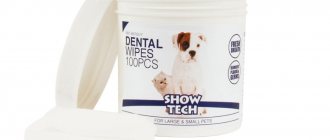Home » Useful Information
A healthy and active pet always makes its owner happy. But unfortunately, the disease can overtake anyone: not only a “walking” pet, but also an absolutely domestic furry one. The specialist makes a diagnosis and determines the course of treatment. Injections are often prescribed. Of course, you can visit the clinic every day, but when injections need to be given not once, but twice, or even three times a day, it is easier to learn how to carry out these manipulations yourself.
- 2 In what places is a cat given an injection?
2.1 Rules for the manipulation
- 4.1 Intramuscular injection into the thigh
4.1.1 Video: how to give an intramuscular injection to a cat
- 4.2.1 Video: how to inject a cat at the withers
Which syringe to use for injection
Injection is the administration of liquid medications using a syringe subcutaneously, intramuscularly, or intravenously. There are two more types of injections: intraosseous and intraperitoneal. But these manipulations can only be done by a specialist in a clinical setting. And intravenous injection is difficult to carry out independently. Owners can easily learn how to do subcutaneous and intramuscular injections themselves.
The syringe for injection should be selected in accordance with the prescribed drug and its quantity required for administration. For small doses, within 1 ml, you should choose an insulin syringe. It has a thin needle, and measuring the drug in a dose of less than 1 ml is much easier thanks to a more convenient scale. In all other cases, a syringe of 2 ml is used.
The insulin syringe has a thin needle and a convenient measuring scale
Where to give an injection to a cat
The places for injections in a cat are strictly determined by the anatomy of the animal. They are determined according to the prescription of a specialist and depend on the drug prescribed. Main injection sites:
- for subcutaneous injections: withers;
- femoral fold;
- front of thigh;
Subcutaneous injections are performed in those parts of the body where it is possible to gather the cat’s skin into a large fold
- back of the thigh;
The cat has well-developed muscles on the back of the thigh and shoulder, so intramuscular injections are given here
Rules for manipulation
Although any owner can learn how to give injections to their pet, it is still a difficult task that requires not only certain skills, but also knowledge:
- It is better to give the injection to a cat with a partner. Even the calmest animal can behave unpredictably. If there are no assistants, then the cat must be securely secured; a harness or a bathing net will help. In the absence of these devices, you can use a simple technique: the cat is tightly swaddled in a blanket, large towel or sheet. This will save both the cat and the owner from possible injuries. Only the injection sites remain free: the thigh or withers.
A cat bathing net will help secure your pet during injections.
- The injection is given only with a sterile disposable syringe. Touching the needle with your hands is strictly prohibited. If the needle has been damaged, it must be replaced. The injection site does not need to be disinfected; the cat has everything provided by nature: its skin is covered with a fatty film, which has powerful antibacterial properties. But a person’s hands must be treated with an antiseptic.
- Medicine from the refrigerator must be warmed to body temperature. It's about 37 degrees.
- The skin at the injection site should be healthy and without damage.
- It is better to entrust the introduction of oil preparations to a specialist. But if this is not possible, then after inserting the needle you need to make sure that it does not fall into the vessel. To do this, after the puncture, you need to slightly pull the syringe plunger back. If no blood appears in the syringe, then the medicine can be administered. If the oil preparation gets into the bloodstream, it is deadly for your pet.
- You cannot mix drugs in one syringe unless prescribed by a doctor.
- Intramuscular injections are best done alternately in different paws. This will relieve unnecessary pain and allow time for healing from the previous injection. Actually, the same sequencing technique is used in humans.
- After the injection, be sure to give a treat.
Heat
A slight increase in the animal’s body temperature after injection is considered an adequate reaction of the body.
- But if the high temperature persists for more than 3 days, then you need to immediately go to the veterinary clinic.
- Typically, this complication is associated with an allergy to a drug or the development of an inflammatory process.
We hope that this material was useful to you, and now you can give your cat an injection yourself. Good luck!
Preparing for the injection
To carry out the injection, you need to prepare everything in advance:
- The injection must be performed on a flat, stable surface. It shouldn't be slippery. This could be a regular table.
- It is necessary to make sure that the chosen drug is correct. Ampoules are easily confused, especially if different people gave the injections. It doesn’t hurt to read the recipe again so as not to make a mistake with the dosage.
- Medicine stored in the refrigerator must first be warmed to a temperature of 37 degrees. To do this, you need to hold it in your palms for several minutes.
- The ampoule is filed or broken at the mark in the upper part. In order to simply break the so-called cap, you need to wrap it with cotton wool and press back on the break.
- After opening the ampoule, the medicine must be drawn into a syringe. To do this, remove the cap from the needle, which is carefully inserted into the ampoule. To make it easier to take the medicine, the ampoule or vial can be tilted or turned over. If you need to dilute the powder, then the needle must be replaced after piercing the rubber cap of the vial and taking the drug.
It is better to carry out all manipulations with sterile rubber gloves.
- After taking the drug, the needle must be protected with a cap. Ideally, it should be replaced with a new one. The syringe must be turned upside down with the needle and excess air released. If air bubbles have settled on the inner wall of the syringe, you can lift them up by lightly tapping the body. If it was not possible to get rid of all the bubbles, then the product may not be administered completely.
- You will need a container like a container in which you can put all the waste: empty ampoules, needles, etc.
The appearance of abscesses
Swelling and ulcers after injection can only appear if you performed this procedure incorrectly. A dangerous microorganism or bacterium penetrates into a small wound, resulting in an infection, accompanied in most cases by tissue inflammation.
The swelling may go away on its own after some time. If this does not happen, then an abscess forms, they are already removed through surgery, after the operation the veterinarian prescribes a course of anti-inflammatory drugs.
How to give a cat an injection
When preparing for the injection, it is advisable to talk with your pet. The voice should be smooth, the intonation should be soothing. It is important to remember that everything needs to be done quickly: the pet simply will not allow you to mess around.
The rate of administration of the drug depends on its purpose. So, painkillers and antibiotics are very painful. A quick introduction will cause a lot of unpleasant sensations for your pet, so this should be done slowly, but without delay. The administration of any drug should be moderate in speed, approximately 1 ml in 2-3 seconds. Rapid insertion may cause a painful lump to form, making the next injection difficult.
Intramuscularly into the thigh
Intramuscular injections are prescribed when subcutaneous administration of the drug is ineffective, and intravenous infusions are impossible for a number of reasons. An intramuscular injection, or injection into the thigh, is given in the back of the thigh. If you feel the curve of the thigh above the knee, you can find a small hole in the muscle. This is the injection point.
The procedure is carried out as follows:
- It is important to ensure that the muscle is relaxed. To do this, you need to slightly bend your paw and massage the injection site.
- The syringe is inserted at an acute angle perpendicular to the thigh line. The depth of needle insertion is approximately 1 cm, no more. The muscle is thin and there is a risk of damaging the needle tip if it hits bone.
- The medicine is administered at a moderate speed. Do not turn the syringe at the time of injection.
- The needle should be removed in the same direction as when the syringe was inserted. Once the needle is removed, the cat can be released.
Video: how to give an intramuscular injection to a cat
Subcutaneous injection
A subcutaneous injection is placed in the withers above the shoulder blades.
It is more convenient to place a subcutaneous injection at the withers of a cat
The manipulation is carried out as follows:
- The skin is collected with your fingers and pulled upward, forming a skin fold.
- The needle is inserted into the base of the fold. At first you feel resistance, then the needle seems to “fall through”.
- The drug is administered.
- After completing the administration of the medicine, the needle is first removed, then the skin fold is released.
The withers are a less painful place for the procedure for the pet and easier for the owner. Therefore, it is difficult to make a mistake or harm a cat. But nevertheless you need to be careful. When injecting the medicine into the withers, you need to pay attention to the following point: is the hair on the back of the fold dry? Often, inexperienced owners pierce the entire fold, the needle comes out, and the medicine simply flows out. The exit of the needle from the reverse side may not be noticeable, and only damp wool will indicate an error.
Using the same technology, a subcutaneous injection is given to the cat in the crease of the front part of the thigh.
I myself had to give cats subcutaneous injections in the withers. This is not a difficult matter. But I will never forget the very first injection. I carefully studied several videos on the Internet and basically had an idea of what needed to be done. The cat also sat quietly. But despite this, my hands were shaking violently. I filled the syringe with the medicine in advance. All that remained was to remove the cap and inject the drug. Previously, I had the opportunity to give intramuscular injections to my children and husband, but cats have another difference from people - very thick skin, at least on the withers. The needle seemed to encounter some kind of obstacle on its way, and then smoothly entered under the skin. I must say, the cat behaved as if nothing had happened at all. Apparently, the withers are an absolutely painless place.
Video: how to give an injection to a cat at the withers
Other injections
Intravenous, intraosseous and intra-abdominal injections are given only by specialists with good experience. Such injections are needed for the fastest possible effect of the drug on the body, when the disease is very serious or the minutes are counting. You should not rely on your own dexterity; simple skill in this matter is not enough.
Actions for good
First of all, come to terms with the idea that this is a necessity. Moreover, it is extremely important for the health of your pet. And of course, do not choose medications yourself. Only the veterinarian's prescription must be carried out unconditionally. By the way, in this case, an on-site specialist will explain to you how to give your cat an injection in the withers.
The second step is to calm down. Animals react very strongly to your emotions, so before you start chasing your cat, prepare a syringe, a blanket to wrap your pet in, and take a few deep breaths. Now you can go in search of the patient.
